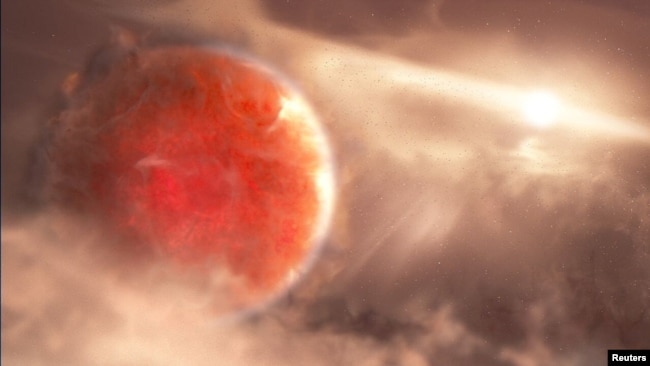巨大惑星の誕生観察!!
原始惑星が本当に成長するのですね!!
その過程が見られるなんて、なんてすごいことなんでしょう!!
VOAで英語を学び、宇宙の神秘に近づきたい!!
天文学者、巨大な惑星が誕生する様子を観測(和訳)
Astronomers Observe Huge Planet Being Formed
April 07,2022
最近、科学者たちは、形成初期の大きな惑星を観測しました。この惑星は、すでに木星の9倍の質量があります。
研究者たちは、ハワイにあるすばる望遠鏡とハッブル宇宙望遠鏡を使って、この惑星を発見し研究しました。この惑星は、非常に遠くにある若い星のまわりを回っているガス惑星です。ガス惑星は、太陽系の木星や土星のような惑星です。水素とヘリウムで構成されています。そのガスが、惑星の最内部にある小さな固体の核を取り囲んでいるのです。
「この惑星はまだ誕生して間もないと思われます」と、すばる望遠鏡と NASA エイムズ研究所の天体物理学者テイン・カリー氏は語ります。彼は、Nature Astronomy 誌に掲載された研究の筆頭著者です。また彼は、「これはガス惑星がこれまでに観測された中で、最も早い時期に形成されたことを示す証拠です」とも述べています。
この惑星は、地球から約9.5兆キロメートル離れたABアウリガエという星を取り囲んでいます。この星の画像は、2021年の映画 "Don't Look Up" に登場しました。
太陽系外の惑星、太陽系外惑星、は約5,000個確認されています。AB Aur bと呼ばれるこの惑星は、その中でも最大級の大きさです。
原始惑星と呼ばれる-形成途中の惑星は、他の恒星のまわりで1つだけ観測されています。
既知の太陽系外惑星のほとんどは、太陽とその最も遠い惑星である海王星を隔てる距離の範囲内で、恒星の周りを回っています。しかし、この惑星は太陽から海王星の3倍、地球からの距離の93倍もの距離を公転しています。
その形成は、通常の惑星の形成方法とは異なる過程をたどっているようです。
オリビエ・ギュイヨン氏は、すばる望遠鏡とアリゾナ大学の天文学者です。彼はこの惑星研究の共同執筆者です。ギュイヨン氏によれば、ほとんどの惑星は岩石質のコアに固体がゆっくりと成長することで形成されるというのが通常の考え方だそうです。ガス惑星は、固体の核が十分に大きくなってガスの層を形成し始める前に、このプロセスを経ることになると言います。
このような状況で、若い星の周辺にある原始惑星は、塵から大きな岩石サイズの固体にゆっくりと成長します。このコアが地球の数倍の質量に達すると、周囲の塵やガスからガスを集め始めます。
「この過程では、軌道距離の大きな巨大惑星を形成することはできないので、この発見は惑星形成に関する我々の理解を覆すものです。」とギュイヨン氏は語ります。
研究者らは、AB Aur b が恒星の周囲が冷却される状況で形成され、そして、重力によって1つまたは複数の巨大な塊に分解され、惑星が形成されると考えられています。
ABアウリゲ星は、太陽の約2.4倍の大きさで、約60倍明るく輝いています。年齢は約200万歳で、45億年前の太陽と比較すると非常に若いのです。
「新しい天文学の観測は、現在の理論に絶えず挑戦し続け、最終的には宇宙の理解を深めることになるのです。」と、ギュイヨン氏は話します。
さらに、「惑星形成は非常に複雑で厄介なものであり、まだ多くの驚きが待ち受けています。」とも述べています。
Astronomers Observe Huge Planet Being Formed
Scientists have recently observed a large planet at an early stage of formation. The planet is already nine times the mass of Jupiter.
The researchers used the Subaru Telescope in Hawaii and the Hubble Space Telescope to find and study the planet. It is a gas giant orbiting an unusually far away young star. Gas giants are planets, like our solar system's Jupiter and Saturn. They are made up of hydrogen and helium. Those gases surround a smaller solid core, the innermost part of a planet.
"We think it is still very early on in its 'birthing' process," said astrophysicist Thayne Currie of the Subaru Telescope and the NASA-Ames Research Center. He is the lead writer of the study that appeared recently in the publication Nature Astronomy. "Evidence suggests that this is the earliest stage of formation ever observed for a gas giant," he added.
The planet surrounds a star called AB Aurigae, about 9.5 trillion kilometers from Earth. An image of the star appeared in the 2021 film "Don't Look Up."
About 5,000 planets beyond our solar system, or exoplanets, have been identified. This one, called AB Aur b, is among the largest.
Planets in the process of formation - called protoplanets - have been observed around only one other star.
Almost all known exoplanets have orbits around their stars within the distance that separates our sun and its most faraway planet, Neptune. But this planet orbits three times as far as Neptune from the sun and 93 times Earth's distance from the sun.
Its formation appears to be following a different process than the way planets usually form.
Olivier Guyon is an astronomer with the Subaru Telescope and the University of Arizona. He is a co-writer of the planet study. Guyon said the usual thinking is that most planets form by the slow growth of solids onto a rocky core. He noted that gas giants go through this process before the solid core is large enough to start layering gases.
In this situation, protoplanets in the area surrounding a young star slowly grow out of dust- to large rock-sized solid objects. If this core reaches several times Earth's mass, they begin gathering gas from the surrounding dust and gas.
"This process cannot form giant planets at large orbital distance, so this discovery challenges our understanding of planet formation," Guyon said.
The researchers believe AB Aur b is forming in a situation in which the area around the star cools. Gravity then causes it to break up into one or more huge masses that form into planets.
The star AB Aurigae is about 2.4 times bigger than our sun and almost 60 times brighter. It is about 2 million years old -- very young compared to our 4.5-billion-year-old sun.
"New astronomical observations continuously challenge our current theories, ultimately improving our understanding of the universe," Guyon said.
He added, "Planet formation is very complex and messy, with many surprises still ahead."
Words in This Story
layer – v. to form or arrange one thickness of something over another
challenge – n. a difficult task or problem
messy – adj. not clean or tidy
